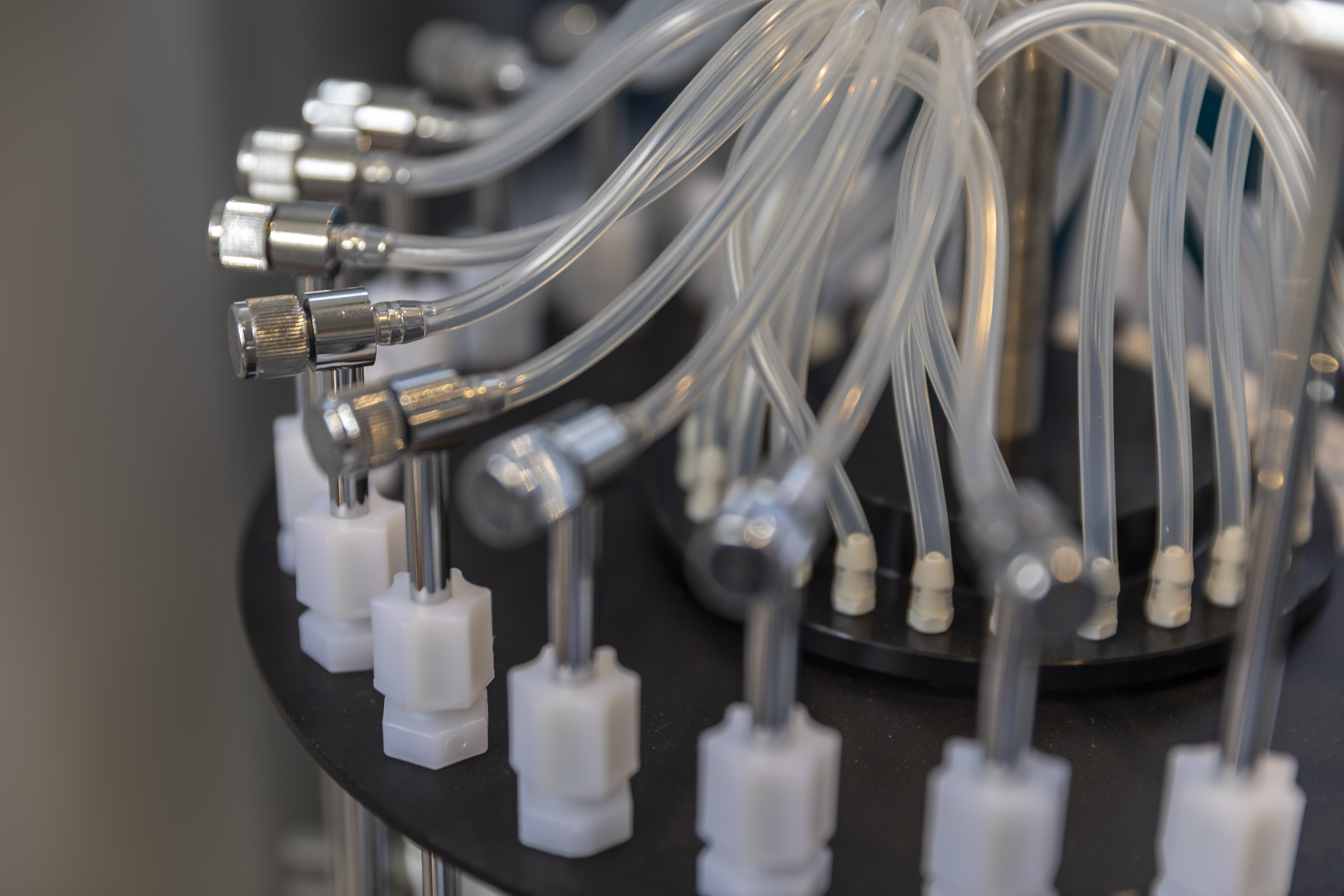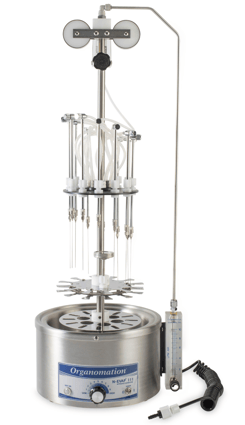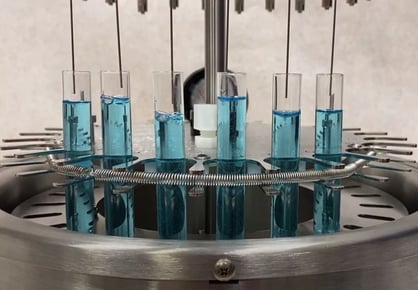
Skip directly to the section you're looking for:
- Nitrogen Blowdown Evaporator: Pressure vs. Flow
- How Pressure and Flow are Related in Organomation Nitrogen Evaporator Systems
- How to Adjust Pressure and Flow on an Organomation Nitrogen Blowdown Evaporator
When a nitrogen blowdown evaporator is used in sample preparation, it's fairly common for the terms "gas flow" and "gas pressure" to be used interchangeably. However, these terms have very specific and different meanings that are important to understand when using a nitrogen dryer for sample concentration.
If you've ever wondered why pressure drops when gas flow is turned on, or why pressure needs to be set even when the flow rate has been stopped, you're not alone. These issues can cause a lot of confusion. In this article, we'll get into the fine details between gas pressure and gas flow, so that you can make a smarter decision when selecting your laboratory concentrator.
Nitrogen Blowdown Evaporator: Pressure vs. Flow
 Let's start by getting into the differences between the two terms. Gas pressure has to do with how highly compressed the air is in the device. One example of this would be the gas pressure stored in a vehicle tire. A bicycle may have 15-20 PSI, or pounds per square inch, of pressure, which is why they will indent slightly when you push on them with your thumb. By comparison, an average car tire will be around 35 PSI, and a tire on a semi truck is 105-110 PSI. That means that when comparing the same amount of space, you're storing air that is twice the pressure of a bicycle tire in a car tire, or seven times the pressure in a semi tire.
Let's start by getting into the differences between the two terms. Gas pressure has to do with how highly compressed the air is in the device. One example of this would be the gas pressure stored in a vehicle tire. A bicycle may have 15-20 PSI, or pounds per square inch, of pressure, which is why they will indent slightly when you push on them with your thumb. By comparison, an average car tire will be around 35 PSI, and a tire on a semi truck is 105-110 PSI. That means that when comparing the same amount of space, you're storing air that is twice the pressure of a bicycle tire in a car tire, or seven times the pressure in a semi tire.
By comparison, flow has to do with how much gas is moving through a system, which is often measured in liters per minute, or LPM. A good example of this is comparing a trim nailer with a paint sprayer. The trim nailer may only require a very small flow of air, because it will only use small amounts of it for very short periods of time to push a small, thin nail into a piece of wood or other substrate. Using those small amounts won't drop the overall line pressure very much, because the line has sufficient volume to compensate for the loss of air. However, a paint sprayer uses a much larger volume of air, so it must have a much larger flow of air into the system, which corresponds to a higher LPM.
When working with samples, you want to make sure that you're setting your pressure and flow in your nitrogen blowdown evaporator properly. Improper settings, specifically setting the pressure above 30 PSI, can cause too high of pressure in your evaporator system, causing tubing to pop off and potential damage to the system.
How Pressure and Flow are Related in Organomation Nitrogen Evaporator Systems
In our example in the introduction, we mentioned how pressure will drop when flow is started in a system. This happens because a nitrogen dryer is an open system and the gas is now moving onto the samples and dissipating, causing a reduction in the system’s pressure (pressure in the tubing and manifold). The amount of pressure reduction you will see is determined by the amount of gas escaping the system, which is impacted by the gauge of needles used and the number of sample positions that are open. Since this drop in pressure is intentional in order to protect the evaporator from any internal damage, it's important to have pressure turned on and properly set prior to opening up the flow. You can then fine-tune the gas flow and pressure using the flow valve on the system, rather than the pressure setting on your gas source.
A common misconception is that the flow valve on the evaporator ONLY controls gas flow, when in reality, it controls BOTH gas flow and pressure. Although it’s most common to measure nitrogen output to the samples in terms of flow since it’s added linearly across samples, it’s just as accurate to measure this output in terms of pressure. We are now referring to the gas pressure on the samples, rather than the system’s pressure.
Gas flow and gas pressure maintain a positive correlation when adjusted using the flow valve on the nitrogen evaporator system. As you decrease the flow via the flow valve, the pressure will also decrease, and as you increase the flow, the pressure will also increase. This positive correlation has to do with the amount of nitrogen flowing through the evaporation system relative to the total area through which the gas can escape.
Let’s say for example you have all 12 of your sample positions open and you are using 19 gauge needles. (This defines the total area through which the gas can leave the system). You start the evaporation process at a flow rate of 0.20 LPM. This is a relatively low amount of gas moving through the system, meaning the particles have lots of room to move, and lots of room to leave the system, leading to less particle collisions and ultimately a low pressure. Now, let’s say your samples are taking a bit too long to evaporate so you decide to increase the flow to 0.35 LPM using the flow valve. There is now almost double the amount of nitrogen moving through the system, but the total area through which the gas can escape hasn’t changed. The gas particles have less room to move, and less room to leave the system, leading to an increase in particle collisions and ultimately a higher pressure.
How to Adjust Pressure and Flow on an Organomation Nitrogen Blowdown Evaporator
Whether you’re using a stored nitrogen source or a nitrogen gas generator, it’s tempting to try to control both pressure and flow at the gas source. In reality, optimizing gas control will involve tweaking both the settings on your gas source, and on your blowdown evaporator. As previously mentioned, it’s important to properly set the gas pressure at your gas source first.
We generally recommend that gas input pressure for Organomation evaporators be set no higher than 30 PSI at the gas source with the flow shut off. If the pressure was set to 30 PSI with the flow open, and the flow was then restricted or stopped, the pressure would rise above 30 PSI, causing hoses to pop off among other issues that could cause damage to the system. If your gas source is unable to be stepped down to 30 PSI or is unable to be controlled with precision, Organomation offers pressure reducing regulators that will provide you with optimal pressure levels and control. (Please reach out to sales@organomation.com for more information on our regulators.)
After this point, leave the pressure alone and adjust the flow to the required level using the flow meter on the evaporator. We recommend 0.33 liters per minute per sample as a starting point. If you notice that your samples are splattering or there’s excessive turbulence, turn down your gas flow using the flow meter. If you notice your samples are evaporating too slowly or there is absolutely no sign of turbulence on the sample’s surface, turn up your gas flow at the flow meter. You’ll know you have the proper gas settings when a small dimple forms on the sample’s surface.
If these tweaks in flow do not provide optimal results (either your flow is still too high or too low), your pressure will need to be readjusted. Although not recommended, if you needed to turn up your gas pressure at the source during your sample preparation, make sure to turn it back down again so that it does not exceed 30 PSI when the flow is shut off. Forgetting to do so can lead to over-pressurizing and damaging your system.
Understanding how certain factors can impact your gas flow/pressure in an Organomation evaporator is a very important step in sample preparation. If you're developing a new process, take the time to test different pressures and flow rates on blanks samples to ensure that you're able to get the results you need.
If you're ready to explore the next step in adding a nitrogen blowdown evaporator to your laboratory equipment, please feel free to reach out to our sales team at sales@organomation.com for more details.
